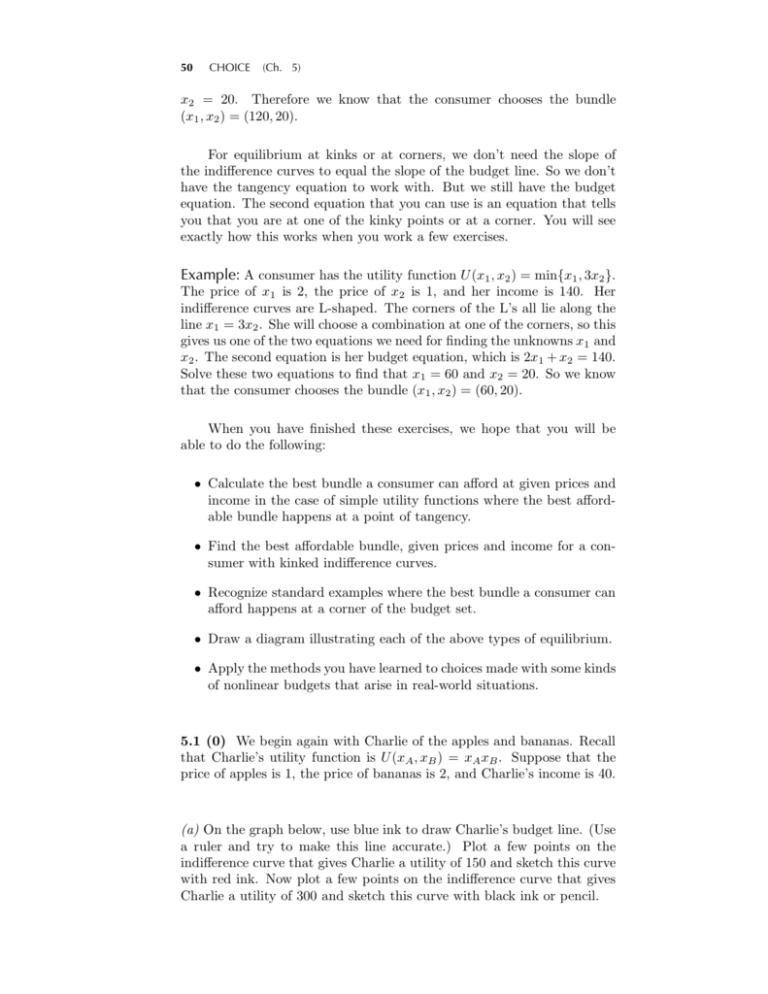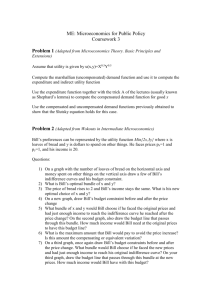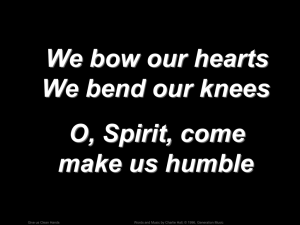Consumer Choice Exercises: Utility & Budget Constraints
advertisement

50
CHOICE
(Ch. 5)
x2 = 20. Therefore we know that the consumer chooses the bundle
(x1 , x2 ) = (120, 20).
For equilibrium at kinks or at corners, we don’t need the slope of
the indifference curves to equal the slope of the budget line. So we don’t
have the tangency equation to work with. But we still have the budget
equation. The second equation that you can use is an equation that tells
you that you are at one of the kinky points or at a corner. You will see
exactly how this works when you work a few exercises.
Example: A consumer has the utility function U (x1 , x2 ) = min{x1 , 3x2 }.
The price of x1 is 2, the price of x2 is 1, and her income is 140. Her
indifference curves are L-shaped. The corners of the L’s all lie along the
line x1 = 3x2 . She will choose a combination at one of the corners, so this
gives us one of the two equations we need for finding the unknowns x1 and
x2 . The second equation is her budget equation, which is 2x1 + x2 = 140.
Solve these two equations to find that x1 = 60 and x2 = 20. So we know
that the consumer chooses the bundle (x1 , x2 ) = (60, 20).
When you have finished these exercises, we hope that you will be
able to do the following:
• Calculate the best bundle a consumer can afford at given prices and
income in the case of simple utility functions where the best affordable bundle happens at a point of tangency.
• Find the best affordable bundle, given prices and income for a consumer with kinked indifference curves.
• Recognize standard examples where the best bundle a consumer can
afford happens at a corner of the budget set.
• Draw a diagram illustrating each of the above types of equilibrium.
• Apply the methods you have learned to choices made with some kinds
of nonlinear budgets that arise in real-world situations.
5.1 (0) We begin again with Charlie of the apples and bananas. Recall
that Charlie’s utility function is U (xA , xB ) = xA xB . Suppose that the
price of apples is 1, the price of bananas is 2, and Charlie’s income is 40.
(a) On the graph below, use blue ink to draw Charlie’s budget line. (Use
a ruler and try to make this line accurate.) Plot a few points on the
indifference curve that gives Charlie a utility of 150 and sketch this curve
with red ink. Now plot a few points on the indifference curve that gives
Charlie a utility of 300 and sketch this curve with black ink or pencil.
NAME
51
Bananas
40
Red
curves
30
Black curve
Pencil line
20
10
0
e
Blue
budget
line
a
10
20
30
40
Apples
(b) Can Charlie afford any bundles that give him a utility of 150?
(c) Can Charlie afford any bundles that give him a utility of 300?
Yes.
No.
(d) On your graph, mark a point that Charlie can afford and that gives
him a higher utility than 150. Label that point A.
(e) Neither of the indifference curves that you drew is tangent to Charlie’s
budget line. Let’s try to find one that is. At any point, (xA , xB ), Charlie’s
marginal rate of substitution is a function of xA and xB . In fact, if you
calculate the ratio of marginal utilities for Charlie’s utility function, you
will find that Charlie’s marginal rate of substitution is M RS(xA , xB ) =
−xB /xA . This is the slope of his indifference curve at (xA , xB ). The
slope of Charlie’s budget line is
−1/2
(give a numerical answer).
(f ) Write an equation that implies that the budget line is tangent to an
−xB /xA = −1/2. There are
indifference curve at (xA , xB ).
many solutions to this equation. Each of these solutions corresponds to
a point on a different indifference curve. Use pencil to draw a line that
passes through all of these points.
52
CHOICE
(Ch. 5)
(g) The best bundle that Charlie can afford must lie somewhere on the
line you just penciled in. It must also lie on his budget line. If the point
is outside of his budget line, he can’t afford it. If the point lies inside
of his budget line, he can afford to do better by buying more of both
goods. On your graph, label this best affordable bundle with an E. This
happens where xA =
20 and xB = 10. Verify your answer by
solving the two simultaneous equations given by his budget equation and
the tangency condition.
(h) What is Charlie’s utility if he consumes the bundle (20, 10)?
200.
(i) On the graph above, use red ink to draw his indifference curve through
(20,10). Does this indifference curve cross Charlie’s budget line, just touch
it, or never touch it?
Just touch it.
5.2 (0) Clara’s utility function is U (X, Y ) = (X + 2)(Y + 1), where X
is her consumption of good X and Y is her consumption of good Y .
(a) Write an equation for Clara’s indifference curve that goes through the
36
point (X, Y ) = (2, 8). Y = X+2 −
Clara’s indifference curve for U = 36.
1.
On the axes below, sketch
Y
16
U=36
12
11
8
4
0
4
8
11
12
16
X
(b) Suppose that the price of each good is 1 and that Clara has an income
of 11. Draw in her budget line. Can Clara achieve a utility of 36 with
this budget?
Yes.
NAME
53
(c) At the commodity bundle, (X, Y ), Clara’s marginal rate of substitution is
Y +1
− X+2
.
(d) If we set the absolute value of the MRS equal to the price ratio, we
have the equation
Y +1
X+2
= 1.
(e) The budget equation is
X + Y = 11.
(f ) Solving these two equations for the two unknowns, X and Y , we find
X=
5
6.
and Y =
5.3 (0) Ambrose, the nut and berry consumer, has a utility function
√
U (x1 , x2 ) = 4 x1 + x2 , where x1 is his consumption of nuts and x2 is his
consumption of berries.
(a) The commodity bundle (25, 0) gives Ambrose a utility of 20. Other
points that give him the same utility are (16, 4), (9,
8
), (4,
12
), (1,
16 ), and (0, 20 ). Plot these points on
the axes below and draw a red indifference curve through them.
(b) Suppose that the price of a unit of nuts is 1, the price of a unit of
berries is 2, and Ambrose’s income is 24. Draw Ambrose’s budget line
with blue ink. How many units of nuts does he choose to buy?
16
units.
(c) How many units of berries?
4 units.
(d) Find some points on the indifference curve that gives him a utility of
25 and sketch this indifference curve (in red).
(e) Now suppose that the prices are as before, but Ambrose’s income is
34. Draw his new budget line (with pencil). How many units of nuts will
he choose?
16 units.
How many units of berries?
9 units.
54
CHOICE
(Ch. 5)
Berries
20
15
10
Red curve
Blue line
5
Red
curve
Pencil line
Blue
line
0
5
10
15
20
25
30
Nuts
(f ) Now let us explore a case where there is a “boundary solution.” Suppose that the price of nuts is still 1 and the price of berries is 2, but
Ambrose’s income is only 9. Draw his budget line (in blue). Sketch the
indifference curve that passes through the point (9, 0). What is the slope
of his indifference curve at the point (9, 0)?
−2/3.
(g) What is the slope of his budget line at this point?
−1/2.
(h) Which is steeper at this point, the budget line or the indifference
curve?
Indifference curve.
(i) Can Ambrose afford any bundles that he likes better than the point
(9, 0)?
No.
5.4 (1) Nancy Lerner is trying to decide how to allocate her time in
studying for her economics course. There are two examinations in this
course. Her overall score for the course will be the minimum of her scores
on the two examinations. She has decided to devote a total of 1,200
minutes to studying for these two exams, and she wants to get as high an
overall score as possible. She knows that on the first examination if she
doesn’t study at all, she will get a score of zero on it. For every 10 minutes
that she spends studying for the first examination, she will increase her
score by one point. If she doesn’t study at all for the second examination
she will get a zero on it. For every 20 minutes she spends studying for
the second examination, she will increase her score by one point.
NAME
55
(a) On the graph below, draw a “budget line” showing the various combinations of scores on the two exams that she can achieve with a total of
1,200 minutes of studying. On the same graph, draw two or three “indifference curves” for Nancy. On your graph, draw a straight line that goes
through the kinks in Nancy’s indifference curves. Label the point where
this line hits Nancy’s budget with the letter A. Draw Nancy’s indifference
curve through this point.
Score on test 2
80
"L" shaped
indifference
curves
60
40
a
20
Budget line
0
20
40
60
80
100
120
Score on test 1
(b) Write an equation for the line passing through the kinks of Nancy’s
indifference curves.
x1 = x2 .
(c) Write an equation for Nancy’s budget line.
10x1 + 20x2 =
1, 200.
(d) Solve these two equations in two unknowns to determine the intersection of these lines. This happens at the point (x1 , x2 ) =
(40, 40).
(e) Given that she spends a total of 1,200 minutes studying, Nancy will
maximize her overall score by spending
first examination and
tion.
800
400
minutes studying for the
minutes studying for the second examina-
5.5 (1) In her communications course, Nancy also takes two examinations. Her overall grade for the course will be the maximum of her scores
on the two examinations. Nancy decides to spend a total of 400 minutes
studying for these two examinations. If she spends m1 minutes studying
56
CHOICE
(Ch. 5)
for the first examination, her score on this exam will be x1 = m1 /5. If
she spends m2 minutes studying for the second examination, her score on
this exam will be x2 = m2 /10.
(a) On the graph below, draw a “budget line” showing the various combinations of scores on the two exams that she can achieve with a total of 400
minutes of studying. On the same graph, draw two or three “indifference
curves” for Nancy. On your graph, find the point on Nancy’s budget line
that gives her the best overall score in the course.
(b) Given that she spends a total of 400 minutes studying, Nancy will
maximize her overall score by achieving a score of
examination and
0
80
on the first
on the second examination.
(c) Her overall score for the course will then be
80.
Score on test 2
80
60
40
Max.
overall
score
20
;
Preference
direction
0
20
40
60
80
Score on test 1
5.6 (0) Elmer’s utility function is U (x, y) = min{x, y 2 }.
(a) If Elmer consumes 4 units of x and 3 units of y, his utility is
4.
(b) If Elmer consumes 4 units of x and 2 units of y, his utility is
4.
(c) If Elmer consumes 5 units of x and 2 units of y, his utility is
4.
(d) On the graph below, use blue ink to draw the indifference curve for
Elmer that contains the bundles that he likes exactly as well as the bundle
(4, 2).
NAME
61
(e) In December Joe’s marginal rate of substitution between food and
degrees Fahrenheit is
-2.
In August, his MRS is
3.
(f ) Since Joe neither heats nor cools his apartment in September, we
cannot determine his marginal rate of substitution exactly, but we do
know that it must be no smaller than
3.
-2
and no larger than
(Hint: Look carefully at your graph.)
5.10 (0) Central High School has $60,000 to spend on computers and
other stuff, so its budget equation is C + X = 60, 000, where C is expenditure on computers and X is expenditures on other things. C.H.S.
currently plans to spend $20,000 on computers.
The State Education Commission wants to encourage “computer literacy” in the high schools under its jurisdiction. The following plans have
been proposed.
Plan A: This plan would give a grant of $10,000 to each high school in
the state that the school could spend as it wished.
Plan B: This plan would give a $10,000 grant to any high school, so
long as the school spent at least $10,000 more than it currently spends on
computers. Any high school can choose not to participate, in which case it
does not receive the grant, but it doesn’t have to increase its expenditure
on computers.
Plan C: Plan C is a “matching grant.” For every dollar’s worth of
computers that a high school orders, the state will give the school 50
cents.
Plan D: This plan is like plan C, except that the maximum amount of
matching funds that any high school could get from the state would be
limited to $10,000.
(a) Write an equation for Central High School’s budget if plan A is
adopted. C + X = 70, 000. Use black ink to draw the budget line for Central High School if plan A is adopted.
(b) If plan B is adopted, the boundary of Central High School’s budget set
has two separate downward-sloping line segments. One of these segments
describes the cases where C.H.S. spends at least $30,000 on computers.
This line segment runs from the point (C, X) = (70, 000, 0) to the point
(C, X) =
(30,000, 40,000).
(c) Another line segment corresponds to the cases where C.H.S. spends
less than $30,000 on computers. This line segment runs from (C, X) =
(30,000,30,000) to the point (C, X) = (0, 60, 000). Use red
ink to draw these two line segments.
62
CHOICE
(Ch. 5)
(d) If plan C is adopted and Central High School spends C dollars on computers, then it will have X = 60, 000 − .5C dollars left to spend on other
things. Therefore its budget line has the equation
Use blue ink to draw this budget line.
.5C+X=60,000.
(e) If plan D is adopted, the school district’s budget consists of two
line segments that intersect at the point where expenditure on computers is
20,000
and expenditure on other instructional materials is
50,000.
−.5.
(f ) The slope of the flatter line segment is
steeper segment is
−1.
The slope of the
Use pencil to draw this budget line.
Thousands of dollars worth of other things
60
Black budget line (plan A)
Pencil budget line
(plan D)
50
Blue
budget
line
(plan C)
40
30
Red budget line
(plan B)
20
10
0
10
20
30
40
50
60
Thousands of dollars worth of computers
5.11 (0) Suppose that Central High School has preferences that can
be represented by the utility function U (C, X) = CX 2 . Let us try to
determine how the various plans described in the last problem will affect
the amount that C.H.S. spends on computers.
NAME
63
(a) If the state adopts none of the new plans, find the expenditure on
computers that maximizes the district’s utility subject to its budget constraint.
20,000.
(b) If plan A is adopted, find the expenditure on computers that maximizes the district’s utility subject to its budget constraint.
23,333.
(c) On your graph, sketch the indifference curve that passes through the
point (30,000, 40,000) if plan B is adopted. At this point, which is steeper,
the indifference curve or the budget line?
The budget line.
(d) If plan B is adopted, find the expenditure on computers that maximizes the district’s utility subject to its budget constraint. (Hint: Look
at your graph.)
30,000.
(e) If plan C is adopted, find the expenditure on computers that maximizes the district’s utility subject to its budget constraint.
40,000.
(f ) If plan D is adopted, find the expenditure on computers that maximizes the district’s utility subject to its budget constraint.
23,333.
5.12 (0) The telephone company allows one to choose between two
different pricing plans. For a fee of $12 per month you can make as
many local phone calls as you want, at no additional charge per call.
Alternatively, you can pay $8 per month and be charged 5 cents for each
local phone call that you make. Suppose that you have a total of $20 per
month to spend.
(a) On the graph below, use black ink to sketch a budget line for someone
who chooses the first plan. Use red ink to draw a budget line for someone
who chooses the second plan. Where do the two budget lines cross?
(80, 8).






